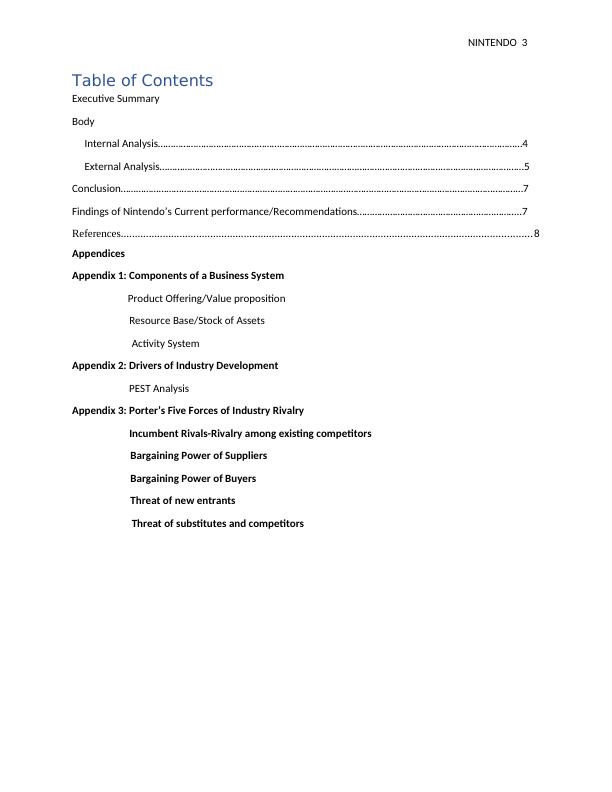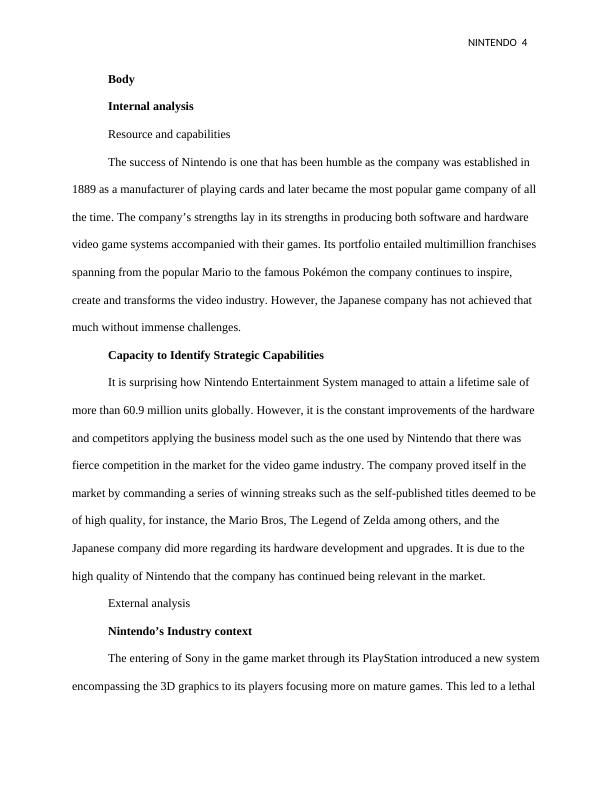Nintendo: A Business Analysis
Added on 2023-06-05
12 Pages2494 Words465 Views
NINTENDO 1
Nintendo
Name
Course
Tutor
University
City/State
Date
Nintendo
Name
Course
Tutor
University
City/State
Date

NINTENDO 2
Executive summary
When Nintendo entered the market for video games, it started with its initial dedicated
console a video game in 1983 and did it with a tremendous support. Nintendo Entertainment
System which happened to be its family computer abroad was to serve as the first console
purposed with a transformative business model. Instead the company not only produced
hardware games for itself but also licensed and supported game developers externally to create
and distribute products for the hardware belonging to Nintendo. Such authorization was strategic
in helping Nintendo gain its share of the market, expanded the software platform network and
provided Nintendo with quality control. Thus, Nintendo became a standard video game on the
market, and it took many years to challenge its monopoly status.
Executive summary
When Nintendo entered the market for video games, it started with its initial dedicated
console a video game in 1983 and did it with a tremendous support. Nintendo Entertainment
System which happened to be its family computer abroad was to serve as the first console
purposed with a transformative business model. Instead the company not only produced
hardware games for itself but also licensed and supported game developers externally to create
and distribute products for the hardware belonging to Nintendo. Such authorization was strategic
in helping Nintendo gain its share of the market, expanded the software platform network and
provided Nintendo with quality control. Thus, Nintendo became a standard video game on the
market, and it took many years to challenge its monopoly status.

NINTENDO 3
Table of Contents
Executive Summary
Body
Internal Analysis................................................................................................................................................4
External Analysis................................................................................................................................................5
Conclusion...............................................................................................................................................................7
Findings of Nintendo’s Current performance/Recommendations.................................................................7
References...................................................................................................................................................8
Appendices
Appendix 1: Components of a Business System
Product Offering/Value proposition
Resource Base/Stock of Assets
Activity System
Appendix 2: Drivers of Industry Development
PEST Analysis
Appendix 3: Porter’s Five Forces of Industry Rivalry
Incumbent Rivals-Rivalry among existing competitors
Bargaining Power of Suppliers
Bargaining Power of Buyers
Threat of new entrants
Threat of substitutes and competitors
Table of Contents
Executive Summary
Body
Internal Analysis................................................................................................................................................4
External Analysis................................................................................................................................................5
Conclusion...............................................................................................................................................................7
Findings of Nintendo’s Current performance/Recommendations.................................................................7
References...................................................................................................................................................8
Appendices
Appendix 1: Components of a Business System
Product Offering/Value proposition
Resource Base/Stock of Assets
Activity System
Appendix 2: Drivers of Industry Development
PEST Analysis
Appendix 3: Porter’s Five Forces of Industry Rivalry
Incumbent Rivals-Rivalry among existing competitors
Bargaining Power of Suppliers
Bargaining Power of Buyers
Threat of new entrants
Threat of substitutes and competitors

NINTENDO 4
Body
Internal analysis
Resource and capabilities
The success of Nintendo is one that has been humble as the company was established in
1889 as a manufacturer of playing cards and later became the most popular game company of all
the time. The company’s strengths lay in its strengths in producing both software and hardware
video game systems accompanied with their games. Its portfolio entailed multimillion franchises
spanning from the popular Mario to the famous Pokémon the company continues to inspire,
create and transforms the video industry. However, the Japanese company has not achieved that
much without immense challenges.
Capacity to Identify Strategic Capabilities
It is surprising how Nintendo Entertainment System managed to attain a lifetime sale of
more than 60.9 million units globally. However, it is the constant improvements of the hardware
and competitors applying the business model such as the one used by Nintendo that there was
fierce competition in the market for the video game industry. The company proved itself in the
market by commanding a series of winning streaks such as the self-published titles deemed to be
of high quality, for instance, the Mario Bros, The Legend of Zelda among others, and the
Japanese company did more regarding its hardware development and upgrades. It is due to the
high quality of Nintendo that the company has continued being relevant in the market.
External analysis
Nintendo’s Industry context
The entering of Sony in the game market through its PlayStation introduced a new system
encompassing the 3D graphics to its players focusing more on mature games. This led to a lethal
Body
Internal analysis
Resource and capabilities
The success of Nintendo is one that has been humble as the company was established in
1889 as a manufacturer of playing cards and later became the most popular game company of all
the time. The company’s strengths lay in its strengths in producing both software and hardware
video game systems accompanied with their games. Its portfolio entailed multimillion franchises
spanning from the popular Mario to the famous Pokémon the company continues to inspire,
create and transforms the video industry. However, the Japanese company has not achieved that
much without immense challenges.
Capacity to Identify Strategic Capabilities
It is surprising how Nintendo Entertainment System managed to attain a lifetime sale of
more than 60.9 million units globally. However, it is the constant improvements of the hardware
and competitors applying the business model such as the one used by Nintendo that there was
fierce competition in the market for the video game industry. The company proved itself in the
market by commanding a series of winning streaks such as the self-published titles deemed to be
of high quality, for instance, the Mario Bros, The Legend of Zelda among others, and the
Japanese company did more regarding its hardware development and upgrades. It is due to the
high quality of Nintendo that the company has continued being relevant in the market.
External analysis
Nintendo’s Industry context
The entering of Sony in the game market through its PlayStation introduced a new system
encompassing the 3D graphics to its players focusing more on mature games. This led to a lethal

End of preview
Want to access all the pages? Upload your documents or become a member.
Related Documents
Competitive Dynamics Report 2022lg...
|12
|2865
|14
Competitive Dynamics in the Global Video Game Industry: A Case Study of Nintendolg...
|12
|2910
|235
Comparison of Marketing Strategies: PlayStation 4 vs Nintendo Switchlg...
|7
|1865
|27
Brand analysis: Nintendolg...
|6
|1613
|108
Marketing Mix Strategy of PlayStation 5 and Nintendo Switch Game Consolelg...
|8
|2112
|453
Marketing Mix Analysis of Playstation and Ninetendo Gaming Consoleslg...
|7
|1818
|423
